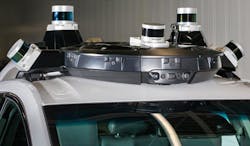GM President Ammann Leaves Parent to Lead Self-Driving Business
General Motors Co. President Dan Ammann will depart the core automotive company to take over its Cruise self-driving car unit, in the clearest sign yet that the automaker sees more growth in selling rides in robotaxis than in its century-old business of selling vehicles.
Ammann will be CEO of Cruise, while the business’s co-founder who runs it now, Kyle Vogt, will be president and chief technical officer. Cruise’s other co-founder, Dan Kan, remains COO. No one will replace Ammann at GM immediately, and the company’s senior executives will instead report directly to CEO Mary Barra.
GM is betting it can dedicate more resources to developing self-driving cars and transportation services in a quest for future profits while cutting back in the rest of the company. As Ammann takes over Cruise, which has hired 1,000 people in two years, the automaker is closing plants and cutting staff in its core business.
For Cruise, the move is about building a bigger management team to transcend from a technology skunkworks focused on creating autonomous cars to a more developed business that brings in revenue. The reshuffling will allow Vogt and Kan to focus on technology while Ammann runs the business and looks for new partners and sources of capital -- and possibly even preparing to spin out the company one day.
“It became clear that Dan Ammann would be the perfect person to help us accomplish our mission,” Vogt said in an interview. “We’ve gotten to see how he thinks and his approach to business. He was with GM during the largest IPO in history. He has experience that Dan Kan and I don’t have.”
For Ammann, the move allows him to lead a tech company that he brought into the GM fold when the automaker acquired it for $1.5 billion in 2016. The automaker’s venture capital fund, GM Ventures, scouted Cruise and Ammann then spearheaded the deal.
“I’m excited to dedicate 100% of my time and energy to helping Kyle and the entire team realize our mission of deploying this technology at scale,” Ammann said.
While GM is dedicating a lot of resources to Cruise, its profits remain in automaking. In the first nine months of this year, Cruise lost $534 million, while the core businesses made $9.7 billion in operating profit. GM and other automakers see the ride-hailing business now dominated by Uber Technologies Inc. and Lyft Inc. growing rapidly. A study by Morgan Stanley and Frost & Sullivan projects that ride-hailing will be a $202 billion business by 2026.
Cruise Partners
That’s why GM is racing to find partners, raise cash and prove the technology works. GM hasn’t said whether the company will be spun out from the automaker or if it would sell stakes to the public. In the spring, GM executives met with financial advisers to discuss those possibilities, but didn’t reach a conclusion on a strategy at that time, people familiar with the matter told Bloomberg.
Cruise has sold stakes in Cruise in private deals. The company attracted a $2.75 billion investment from Honda Motor Co. in October and a $2.25 billion commitment from Japan’s SoftBank Vision Fund before that. The Honda deal valued the unit at $14.6 billion.
Ammann’s appointment is a “natural step” that will help integration with GM while letting Vogt focus on technology, said Michael Ronen, managing partner at SoftBank Investment Advisers.
Ammann said Cruise will be tied to GM for a long time because integrating the company’s self-driving software with the automaker’s cars is a key competitive advantage. “It’s a critical factor,” he said.
Cruise has been working toward developing a ride-hailing business that uses self-driving cars that will first be deployed on public roads late next year. Ammann said that developing self-driving cars for delivery services also is a natural extension of what Cruise does.
GM has said that the company is open to working with other partners, though Ammann declined to say whether he wants to access public markets or other financing sources anytime soon.
“You have seen us take a couple of significant actions and more recently with Honda,” he said. “There is still a lot of work to do and the majority of work lies in front of us.”
Technical Challenges
Like other companies developing self-driving cars, the key challenges have been running the vehicles in bad weather and tough traffic conditions, plus mastering the multitude of challenges that humans encounter on the road.
When GM deploys Cruise cars on public roads, Vogt said, the cars will run in a service and on routes that will be simple enough that the software doesn’t need to master every possible encounter. At the same time, he doesn’t want to restrict the cars to tight routes with very limited distances.
To make the technology more capable, Vogt wants to dedicate most of his time to developing the software, and Ammann’s presence enables him to do that.
“I’ve been doing two to three jobs worth of work,” Vogt said. “This will let me give more attention to developing technology.”
By David Welch
About the Author
Bloomberg
Licensed content from Bloomberg, copyright 2016.
